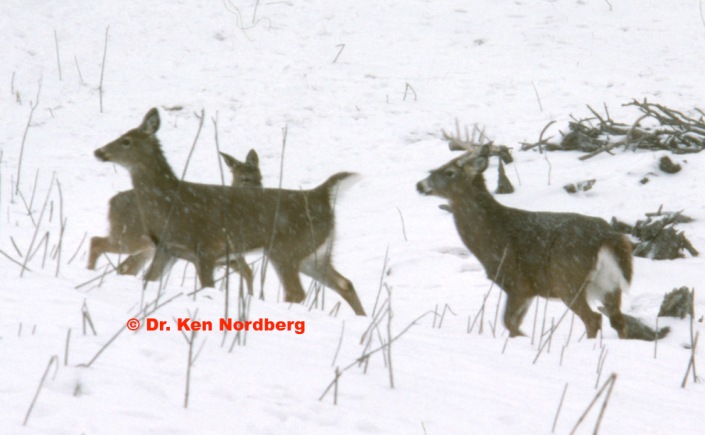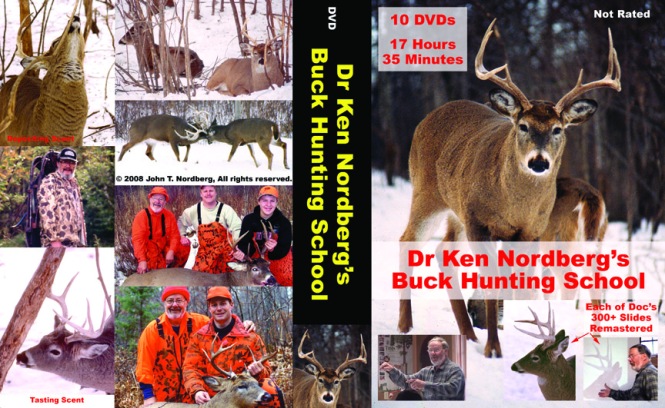Once the primary breeding phase of the whitetail rut begins in November, Rut Phase III, dominant breeding bucks have little time for renewing ground scrapes and antler rubs. Searching for does in heat, accompanying each doe in heat up to a day and a half, breeding each doe four or more times during a 24-26 hour period and likely having to keep a few pheromone crazed lesser antlered bucks away from does in heat is a full time job. For these reasons alone, stand hunting near ground scrapes and using doe and heat buck lures are not as productive as most hunters imagine they should be during this period.
There are other reasons. For one, a dominant breeding buck currently accompanying a doe in heat, and for that matter, any lesser buck that is currently shadowing a breeding pair, will not abandon that doe for any reason other than suddenly discovering a hunter is dangerously near. For another, though an antlered buck currently under the influence of doe-in-estrus pheromone may temporarily be less attentive of its surroundings, the multiple ears, ears and noses of a doe in heat and its young (not including the doe’s yearling buck which won’t be near) will be as attentive as ever, these deer ready to react and/or sound a warning (snort) the moment anything potentially dangerous is discovered. Even greater protection is commonly provided by multiple does in heat and their young. Any doe in heat that is not quickly discovered by its dominant breeding buck will soon begin to search for it, easily found because by this time such bucks reek (by deer standards) with musk and urine, after which the buck will have two does in heat to deal with. On several occasions since 1970 I have counted as many as eleven antlerless deer (does and young) accompanying a dominant breeding buck. When suddenly made aware of nearby danger, a dominant breeding buck will typically abandon a doe in estrus, preferring to depend own its own prowess to avoid danger rather than that of the doe. By nightfall, however, the buck will usually be back with the doe.
If you are old enough to have experienced the extraordinary buck hunting attributable to doe urine containing pheromone back in the 1980s, I’m sure you, like me, wish that kind of hunting still existed today. Many hunters, like two of my sons, who grew up using this lure and still use it, hope some big buck will come along that hasn’t yet learned to steer clear of airborne sources of pheromone accompanied by airborne human odors. These sons are regularly successful at taking mature bucks, often one for the wall, but no more than two that I can recall were attributable to using such a lure since 1990.
So, where does this leave us? Where and how should we hunt mature bucks while breeding is in progress today?
The best place to hunt a mature buck is where it is right now. While breeding is in progress, it’s where a doe in heat is located right now, or soon will be, but not for long (a day and a half at the most). To determine where that is, you have to be aware of habits of does during this period. Being in heat does not greatly alter their habits. When it’s time to eat, does eat and when its time to rest and chew cud, they rest and chew cud. During periods of the day when it is legal to hunt whitetails, whether a doe is in heat or not, expect does to be feeding from first light in the morning until 9–10 AM and from 3–4 PM until dark. Between 10 AM and 3 PM they will be in their bedding areas. Most breeding, occurs in doe bedding areas (which are 10 acres or more in size), meaning the breeding pair may be up and moving about short periods midday. The best places to hunt big bucks while breeding is in progress is therefore a feeding area currently frequented by one or more mature and yearling does in the morning, a doe bedding area midday and the same or a different feeding area currently frequented by one or more mature and yearling does in the afternoon and evening.
The trouble is, any doe you decide to keep an eye on during this period may not currently be in heat. If it isn’t, the dominant breeding buck of the surrounding square-mile will be with a doe somewhere else. You can keep hunting feeding areas favored by does, hoping to eventually find yourself at one in which a doe is accompanied by a dominant breeding buck or you can improve your odds in one of a few ways.
If the feeding area you elect to hunt near is large, a clearcut or farm field for example, it is likely to be shared by multiple does living in adjacent home ranges, in which case your odds will improve considerably. With three mature does and one or two yearling does feeding in the area, the odds at least one doe will be in estrus will be about 5-in-7 (almost a sure thing).
If while hiking to a feeding area stand site early in the morning you come across fresh yearling or mature doe-sized tracks in snow accompanied by fresh tracks of a mature buck that dragged its hooves from track to track (meaning the doe is in heat) and if they were headed toward a feeding area, it is almost 100% certain that buck is with that doe in that feeding area right now. If you find such tracks in the afternoon or evening, your odds of seeing that buck with that doe in the nearest feeding area during the next hours whitetails feed will be excellent. That doe may yet be in heat the following afternoon and evening, but not after that. If you don’t have snow, fresh tracks of a big buck accompanying fresh tracks of a doe is enough to indicate that doe is probably in heat.
Preserving the hunting value of such deer signs requires certain skills and knowledge. If you are unable to discover such deer signs daily without alarming nearby deer and/or you are unable to take quick advantage of such deer signs because you lack a prepared downwind or crosswind stand where deer are currently feeding, these very productive deer signs for trophy buck hunting will have no hunting value for you (much more about this in future blogs).


